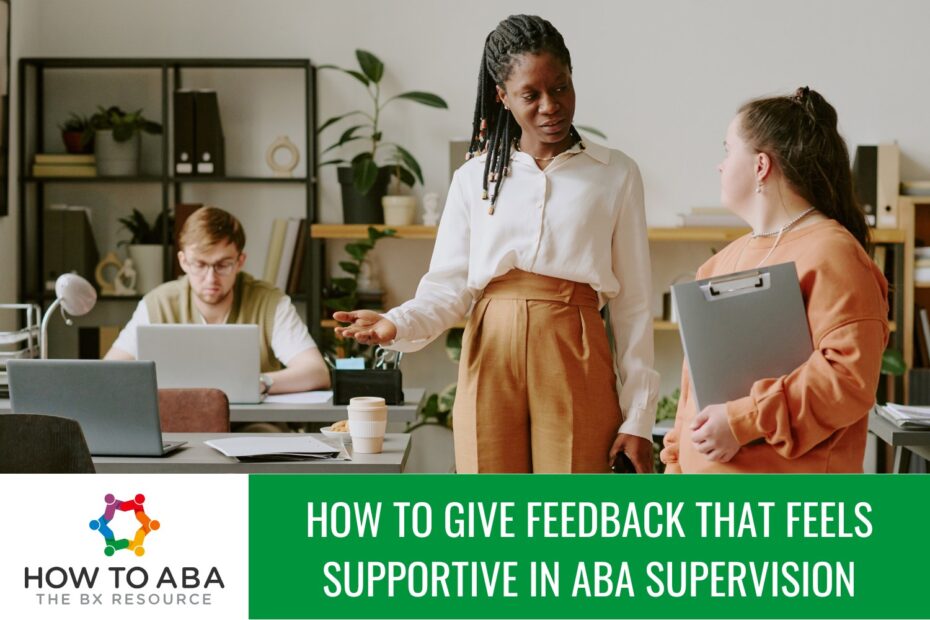If you’ve ever had to give feedback – whether to a supervisee, a colleague, or a parent – you know it’s not always easy. You want your message to be clear and constructive, but you also want the person on the receiving end to feel supported, not deflated. The art of feedback lies in balancing what needs to be said with maintaining trust, motivation, and collaboration.
In ABA, feedback is more than just a performance review; it’s a tool for growth. Done well, it can help shape behavior, refine skills, and build confidence. Done poorly, it can cause defensiveness, anxiety, or even burnout. The good news? Supportive, “sticky” feedback – the kind that motivates change and strengthens relationships – is a skill you can learn and refine.
Here’s how to give feedback that actually sticks.
1. Set the Stage for Success
Before you give feedback, set the right conditions for it to land well. Timing, tone, and setting all matter.
Be intentional about when and where you give feedback.
A rushed comment in a noisy hallway might come across as criticism, even if you meant it kindly. Whenever possible, choose a private, calm setting where both of you can focus.
Create a culture of ongoing feedback.
If feedback only happens when something goes wrong, it becomes a source of stress. When it’s part of regular conversation – celebrating wins, troubleshooting challenges, setting goals – it feels natural and expected. The best supervisors don’t “save up” feedback; they weave it into everyday practice.
Set the expectation early.
Let your supervisees know that feedback is a normal part of growth and learning. When they expect it, they’re less likely to see it as personal criticism and more likely to view it as collaboration.
2. Start with What’s Working
This might sound simple, but it’s one of the most powerful ways to build rapport and ensure your feedback sticks: start with something positive.
Acknowledge the person’s effort, progress, or something they did well before moving into what needs improvement. This isn’t about sugarcoating; it’s about reinforcing desired behaviors and creating a receptive mindset.
Instead of saying:
“You need to take more data during sessions.”
Try:
“I really liked how engaged you were with the client today. I noticed you took data during discrete trials – great start! Let’s look at how we can make sure data collection happens consistently across the whole session.”
The message is the same, but the tone invites collaboration rather than defensiveness.
3. Be Specific, Not Vague
General feedback like “good job” or “you need to improve” doesn’t help anyone grow. Specific feedback gives direction.
If a supervisee delivered a prompt well, describe exactly what they did:
“I like how you paused for two seconds before prompting – that’s exactly what we want to see with least-to-most prompting.”
If something needs correction, explain what to change and why:
“Let’s try providing the prompt right after the instruction next time. That timing helps reduce latency and keeps the client engaged.”
Specific feedback shows that you’re paying attention and that you care about helping the person succeed. It also makes it easier for them to replicate or adjust their behavior next time.
4. Use Objective Language
In ABA, data is everything, and the same principle applies to feedback. Stick to observable, measurable descriptions instead of subjective judgments.
For example, instead of saying:
“You seemed distracted during the session.”
Say:
“I noticed your attention shifted to your notes several times while the client was engaging in the task.”
Objective language removes interpretation and focuses on behavior. It keeps the feedback professional and easier to digest.

5. Collaborate on Solutions
Feedback shouldn’t feel like a lecture; it should feel like teamwork. After you share your observations, invite input. Ask open-ended questions like:
- “How did that part of the session feel to you?”
- “What do you think might help next time?”
- “Would it help if we practiced that skill together?”
When the person feels heard and part of the process, they’re more likely to buy into the feedback and apply it. Collaboration turns feedback into learning, not correction.
6. Balance Praise and Correction
Behavior change thrives on reinforcement, and so does professional growth. If most of your feedback is corrective, even well-intentioned comments can start to feel discouraging.
A good rule of thumb is the 3:1 ratio – for every one area of improvement, highlight at least three positives. The positives don’t need to be big; even small acknowledgments (“I liked how you redirected quickly” or “Your tone was great with the parent”) can go a long way in maintaining morale.
When people feel appreciated, they’re more open to hearing what needs work.
7. Follow Up
Feedback is only valuable if it leads to change. Check in after giving feedback to see how things are going.
You might say:
“Hey, last week we talked about increasing opportunities for manding—how has that been going?”
Following up communicates that you care about their progress and that your feedback wasn’t just a one-time comment. It also reinforces accountability and consistency.
8. Remember: Feedback is a Two-Way Street
The best supervisors also ask for feedback on their own performance. Modeling openness and humility creates a safe environment for learning.
Try ending a supervision session with:
“Is there anything I can do differently to make feedback more helpful for you?”
That small question can make a huge difference in building mutual respect and trust.
Giving feedback that sticks is about being effective. When you combine clarity, compassion, and collaboration, you create an environment where learning feels safe and growth feels achievable.
Supportive feedback isn’t soft; it’s smart. It builds skill, strengthens relationships, and ultimately leads to better outcomes – for supervisees, clients, and the team as a whole.
The next time you’re preparing to give feedback, take a moment to pause and ask yourself: “Will this help the person grow and feel supported?” If the answer is yes, you’re already doing it right.


